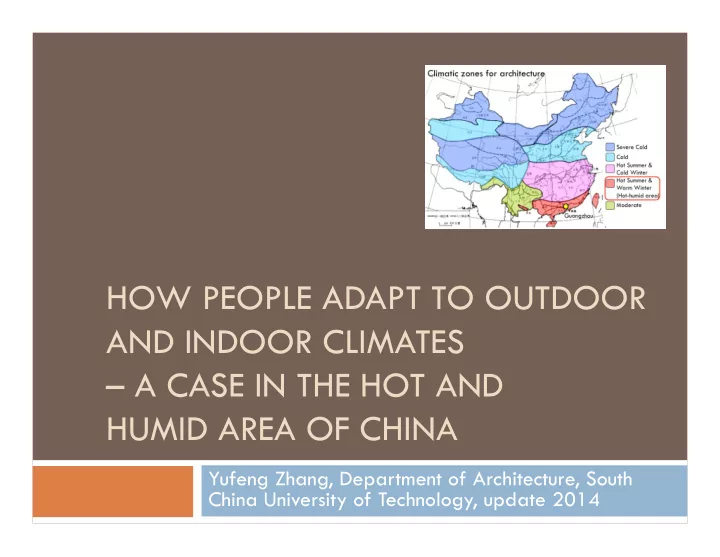

HOW PEOPLE ADAPT TO OUTDOOR AND INDOOR CLIMATES – A CASE IN THE HOT AND HUMID AREA OF CHINA Yufeng Zhang, Department of Architecture, South China University of Technology, update 2014
Methods 60 local people, 30 from NV and 30 from SAC buildings Warmer indoor histories in summer and transition seasons for NV group 20-32ºC, 50-70%, 0.1m/s, MRT=Ta, 0.57clo Both summer and winter experiments Psychological and physiological measurements
Impacts of season 90 NV 3 NV Summer Sum… Winter Winter 2 Heart rate (pulses/min) 80 Thermal sensation y = 0.2521x - 6.8573 y = 0.9896x + 47.109 1 R² = 0.9917 R² = 0.9175 70 0 y = 0.2437x - 6.6028 -1 y = 0.7408x + 46.452 R² = 0.9817 60 R² = 0.8867 -2 50 -3 15 20 25 30 35 15 20 25 30 35 SET (ºC) SET (ºC) Seasonal heat acclimatization that decreases heart rate and increases skin wettedness in summer is confirmed. Seasonal heat acclimatization has no significant impacts on human thermal sensation and comfort.
Impacts of thermal history 3 36 NV NV SAC 35 SAC 2 R² = 0.97622 Skin temperature (ºC) Thermal sensation 34 y = 0.2964x - 7.8318 1 R² = 0.9869 33 0 32 y = 0.2479x - 6.73 -1 R² = 0.9899 31 R² = 0.98382 -2 30 26.4 27.1 -3 29 15 20 25 30 35 15 20 25 30 35 SET (ºC) SET (ºC) A warmer indoor thermal history in warm seasons produces a higher neutral temperature, a lower thermal sensitivity and lower thermal sensations in warm conditions. Indoor thermal history has no significant impacts on physiological responses.
Impacts of climate Location Climate Neutral MT Thermal sensitivity Ref. ( ºC ) (/ ºC ) 25.6 a 0.3376 a America Temperate Nevins et al. (1966) 25.7 a 0.3048 a Denmark Temperate Fanger, (1970) 0.3448 a Japan (summer) Temperate 26.3 Tanabe et al. (1987) 25.3 a 0.2668 b Japan (winter) Temperate Tanabe et al. (1987) 25.8 a 0.4044 a, b Singapore Tropical de Dear et al. (1991) Subtropical 24.9 a, b 0.3666 a Hong Kong Chung and Tong (1990) Guangzhou (NV) Subtropical 26.7 0.2741 Guangzhou (SAC) Subtropical 26.1 0.3263 NV group has a higher neutral MT and a lower sensitivity than others. SAC group is similar with others. Singapore: outdoor history is much less important than indoor history.
Impacts of climate 36 0.6 The present study The present study The Two-Node model The Two-Node model 35 0.5 R² = 0.9905 34 Skin temperature (ºC) Skin wettedness R² = 0.9962 0.4 33 0.3 32 0.2 31 y = -0.0117x 2 + 0.9726x + 15.396 0.1 30 y = 0.0014x 2 - 0.0654x + 0.872 R² = 0.98 R² = 0.9621 29 0.0 15 20 25 30 35 15 20 25 30 35 SET (ºC) SET (ºC) Climactic heat acclimatization that decreases skin temperature and decrease skin wettedness in warm conditions is confirmed. Climactic heat acclimatization has no significant impacts on human thermal sensation and comfort.
Recommend
More recommend